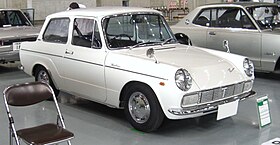Toyota Publica
| Toyota Publica | |
|---|---|

Toyota Publica (UP10) at the Toyota Automobile Museum
|
|
| Overview | |
| Manufacturer | Toyota |
| Also called | Shinjin Publica (신진 퍼블리카) |
| Production | 1961-1978 |
| Body and chassis | |
| Class | Subcompact |
| Body style | 2-door sedan 3-door station wagon 2-door coupé 2-door convertible 2-door pickup truck |
| Layout | FR layout |
| Related |
Daihatsu Consorte Toyota Sports 800 |
| Chronology | |
| Successor | Toyota Starlet |
| P10 Series | |
|---|---|

Toyota Publica DeLuxe (UP10D)
|
|
| Overview | |
| Also called | Toyota 700 |
| Production | Jun 1961–1966 |
| Assembly | Japan |
| Designer | Tatsuo Hasegawa |
| Body and chassis | |
| Body style | 2-door sedan 3-door station wagon 2-door convertible 2-door pickup |
| Layout | FR |
| Powertrain | |
| Engine | 697 cc U air-cooled OHV H2 |
| Transmission | 4-speed manual 2-speed automatic ("Toyoglide") |
| Dimensions | |
| Wheelbase | 2,130 mm (84 in) |
| Length | 3,520 mm (139 in) |
| Width | 1,415 mm (55.7 in) |
| Height | 1,203 mm (47.4 in) |
| Curb weight | 580 kg (1,280 lb) |
| P20 Series | |
|---|---|

Toyota Publica 800 DeLuxe (UP20D)
|
|
| Overview | |
| Production | 1966–Apr 1969 |
| Assembly |
|
| Body and chassis | |
| Body style | 2-door sedan 3-door station wagon 2-door convertible 2-door detachable top 2-door pickup |
| Layout | FR |
| Related | Toyota MiniAce |
| Powertrain | |
| Engine | 790 cc 2U air-cooled OHV H2 |
| Transmission | 4-speed manual 2-speed automatic ("Toyoglide") |
| Dimensions | |
| Wheelbase | 2,130 mm (84 in) |
| Length | 3,520 mm (139 in) |
| Width | 1,415 mm (55.7 in) |
| Height | 1,203 mm (47.4 in) |
| Curb weight | 580 kg (1,280 lb) |
| P30 Series | |
|---|---|

KP50 Publica sedan
|
|
| Overview | |
| Also called | Toyota 1000 Toyota Copain Toyota Osaka (Belgium) |
| Production | April 1969 – 1978 |
| Assembly | Japan |
| Body and chassis | |
| Body style | 2-door sedan 2-door pickup 3-door wagon/van |
| Layout | FR |
| Powertrain | |
| Engine | 790 cc 2U air-cooled OHV H2 993 cc 2K I4 1,077 cc K I4 1,166 cc 3K I4 1,290 cc 4K-J I4 (late pickups) |
| Transmission | 4/5-speed manual 2-speed automatic "Toyoglide" |
| Dimensions | |
| Wheelbase | 2,160 mm (85 in) |
| Length | 3,645 mm (143.5 in) 3,705 mm (145.9 in) (van) 3,865 mm (152.2 in) (pickup) |
| Width | 1,450–1,490 mm (57–59 in) |
| Height | 1,380 mm (54 in) |
| Curb weight | 665 kg (1,466 lb) |
The Toyota Publica is a small car manufactured by the Japanese automaker Toyota from 1961 to 1978. Conceived as a family car to fulfil the requirements of the "national car concept", it was the smallest Toyota car during that period and was superseded in that role by the Toyota Starlet, which itself started out as a version of the Publica. It was available as a 2-door vehicle only, but in a selection of body styles, ranging from the base sedan through a station wagon, convertible, coupé and even a pickup, which outlived the other models by a decade, and spawned other models, such as the Toyota Sports 800 or Toyota MiniAce.
The origins of the Publica can be traced to the "national car" concept of the powerful Japanese Ministry of International Trade and Industry (MITI), which was announced in 1955. The concept stipulated for a vehicle fulfilling several requirements, like maximum speed over 100 km/h (62 mph), weight below 400 kg (882 lb), fuel consumption not exceeding 30 km/L (85 mpg-imp; 71 mpg-US) at the average speed of 60 km/h (37 mph) on a level road, but also notably the requirement that the car would not break down or require significant repairs for at least 100,000 kilometres (62,000 mi).
Although Eiji Toyoda was initially keen to take advantage of the, at that time innovative, FF concept (front-mounted engine with front-wheel drive), it proved technically too complicated for Toyota engineers to be able to complete within the allotted time, so the decision was made to switch to more conventional FR layout. The Publica was inspired by the successful Citroën 2CV which also used a 2-cylinder, air-cooled, horizontally opposed engine, with front-wheel drive. In spite of the fact that the government sources announced that significant tax breaks would be made for cars with engine displacements of less than 500 cc, Toyota decided that such a small engine would provide insufficient power on the highways, and increased the planned displacement to 700 cc. The resulting engine was an air-cooled 697 cc ohv 2-cylinder boxer which produced 28 hp (21 kW), and was known internally as the Toyota U engine. Fortunately for Toyota, the tax incentive announcements did actually not materialize; the displacement did classify in the lowest annual road tax bracket, which helped sales.
...
Wikipedia
